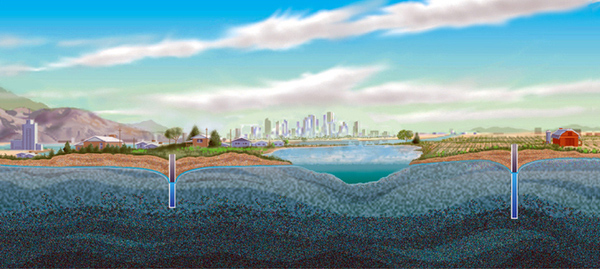Land subsidence situation in Bangkok and its vicinity
The Bangkok area is located in a deep basin of thick or thin soft clay alternating with layers of aquifers. The internal causes of subsidence are natural consolidation, and the compaction of soft clay layer, the second external causes are surface loading, traffic vibration, and other construction-related stress.
There have already been several surveys conducted by organizations such as the Royal Thai Survey Department (formerly Office of National Environmental Board or the National Committee for the Environment Office), the Department of Mineral Resources, (now the Department of Groundwater Resources) and AIT (the Asian Institute of Technology). The first survey carried out in 1978 -1981 found that land subsidence was occurring at more than 10 cm per year. The second survey with contributions from the Royal Thai Survey Department in 1984 covered a total period of 30 years from 1978 to 2008 in Bangkhen, Bueng Kum, Bang Kapi, Prawet District and Samut Prakan Province; the average rate of subsidence was more than 1 meter per year. But after that, there is a gradual decrease in the subsidence rate to a rate of 2 – 3 cm per year, because of improved monitoring and less dependence on groundwater. Otherwise some areas such as the King Mongkut University of Technology vicinity (Bangmod), the Mueang Samut Sakhon District and the Pathum Thani City Hall area, the subsidence rate has been found to be higher than 2 cm.
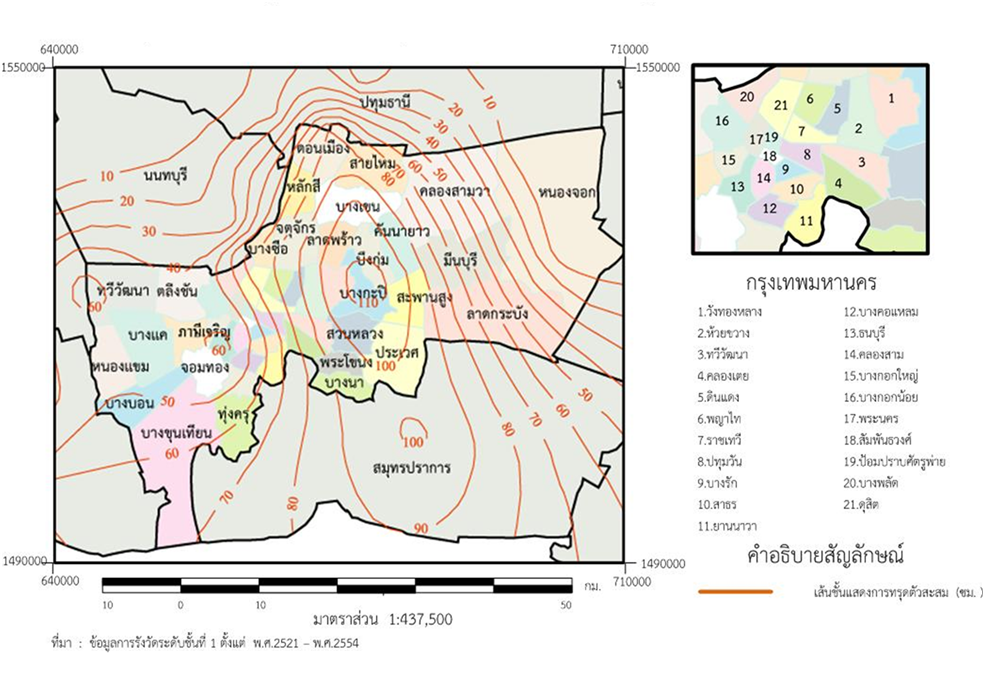
แผนที่แสดงอัตราการทรุดตัวสะสมของพื้นดินกรุงเทพมหานครและปริมณฑล (พ.ศ. 2521-2554) (ที่มา: กรมแผนที่ทหาร)
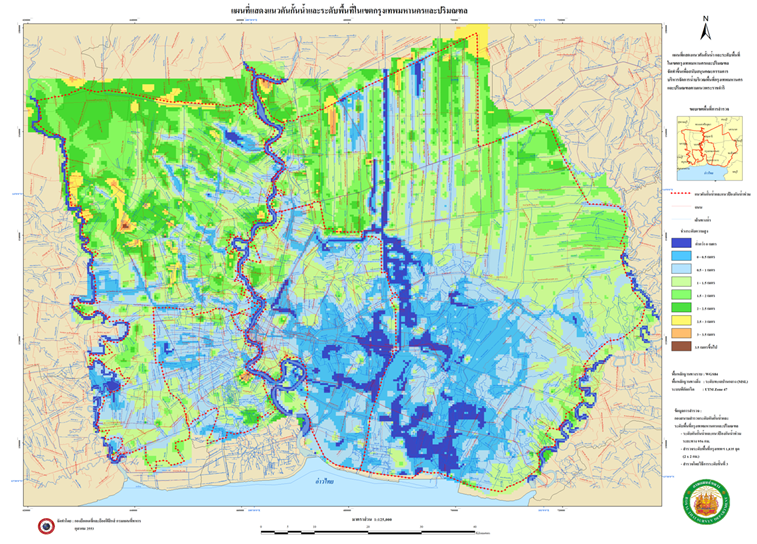
แผนที่แสดงความสูงต่ำของพื้นที่กรุงเทพมหานครและปริมณฑลโดยเทคนิคการประมาณค่า (ที่มา: กรมแผนที่ทหาร)
Other organizations also conducted studies which estimated the following subsidence rates:
The Department of Groundwater Resources’ survey (2006) were intrigued by the findings related to the land-subsidence rates in Ratchathewi District in Bangkok. From 1978 – 1985, the rate was 3.2 cm but, it was only 1.3 cm per year (2006). The lowest groundwater-level was -31 meters below ground level (1997). It rose to -23 meters below ground level (2006). In another area near Ramkhamhaeng University, Hua Mak, Bangkok, the land-subsidence rate was 10 cm a year (from 1978 to 1985), but it was only 1.3 cm a year (2005). The groundwater-level improved from -54 meters to -33 meter below ground level.
In Ladkrabang, Min Buri, Bangkok, the former rate of land subsidence was 3.4 cm per year (1978 – 1999) but decreased to 0.65 cm. per year (2006). The lowest groundwater-level was -69 meters below ground level (1997) but only 41 meters below ground level (2006). East of Bangkok (Bang Phli District, Samut Prakan Province), the rate of land-subsidence was 5.7 cm per year (1986 – 1998) and it lessened to 2.3 cm. per year (2006). The lowest former groundwater-level was -50 meters (1997) which rose to -34 meters below the ground level (2006).
North of Bangkok (Mueang Pathum Thani District), the expected subsidence rate has remained approximately 0.3 cm. per year (since 1986 – 2002). The established bench mark was under repair so the recent measurement was approximate. The groundwater-level improved from -28 meter (1997) to -22 meter (2006). West of Bangkok (Mueang Samut Sakorn District), groundwater use was not severe in the past. The land-subsidence rate was 0.9 cm. per year (1979 - 1989) and increased to 2.6 cm. per year (1990 – 1997). In 2006, it was measured at 2.3 cm. per year which is still regarded as critically high. The groundwater-level has risen from -51 cm in 1997 to -33 cm in 2006.
In 2008, the Department of Marine and Coastal Resources’ survey on land subsidence in Ratchathewi, Hua Mak, Minburi, Bang Phli District, Samut Prakan and Samut Sakorn Province found that the rate was between 0.65 - 2.3 cm. per year.

อัตราการทรุดตัวของพื้นดินในแต่ละพื้นที่ที่ตรวจวัด (ที่มา: กรมทรัพยากรทางทะเลและชายฝั่งในปี, 2551)
A Land-Subsidence Causes in the Bangkok Area Project Study (Chulalongkorn University) points out that subsidence results according from the level of construction-related pressure; from surface loading and groundwater pumping; the natural subsidence rate was around 0.001 – 4 cm per year.

ตารางแสดงอิทธิพลจากปัจจัยต่าง ๆ สำหรับเหตุการณ์ทรุดตัวบริเวณกรุงเทพมหานครและปริมณฑล
ในช่วงปี พ.ศ. 2546-2550 (ที่มา: โครงการศึกษาหาสาเหตุการทรุดตัวของแผ่นดิน
บริเวณกรุงเทพมหานครและปริมณฑล จุฬาลงกรณ์มหาวิทยาลัย, 2552)
To sum up, the land-subsidence rate in Bangkok and its surrounding areas has remained a consistent problem connected directly with urban sprawl. It is a distressing crisis unless appropriately handled. Without the proper implementation of a solution, this could lead to a great disaster. Simply put, the primary cause is from groundwater excess pumping. The usage rate is much higher than the natural accumulation of groundwater.
Groundwater Over-use Sinks Bangkok
Since 1953, Bangkok and its adjacent areas have started to use groundwater intensively for consumption, and commercial and industrial use. Due to its low cost, there has been widespread over-exploitation of groundwater for a long time. This has resulted in various groundwater critical zones and pressure drops affecting land subsidence.
During 1978 – 1982, because the surface water supply system did not keep up with urban and industrial expansion, Bangkok and the surrounding area has relied excessively on pumped groundwater. The Department of Groundwater Resources and the Royal Thai Survey Department have found that 10 mm subsidence a year was primarily from excessive groundwater pumping which outpaced natural retention rates. Therefore, water pressure also dropped.
In Ramkhamhaeng and Bangkapi, Bangkok, the obvious subsidence rate was 108 cm with a lower groundwater level. This occurred during 1978 – 2007 when rapid urban sprawl took place. The land subsidence corresponds with urban and commercial expansion which demanded increased water supply. Since the surface water supply was not sufficient to meet demand, groundwater was used as the main water supply. The increase of underground water use is also correlated to the density of the population, for example, in housing development areas.
Therefore, three levels of groundwater-critical zones were designated in 1983 and 1995. Seven provinces were named: Nonthaburi, Pathum thani, Samut Prakan, Nakhon Pathom, Samut Sakhon and Phra Nakhon Si Ayutthaya. The Cabinet Resolution of 23 May 1995, announced new critical zone covering the seven provinces. The first critical zone included areas with more than 3 cm of land subsidence and groundwater-levels of more than 3 meters decrease a year. The second critical zone includes areas with a rate of 1 – 3 cm and 2-3 cm decrease in the groundwater-level per year. The third critical zone rate is less than 1 cm and less than a 2 cm decrease in the ground-water level each year.
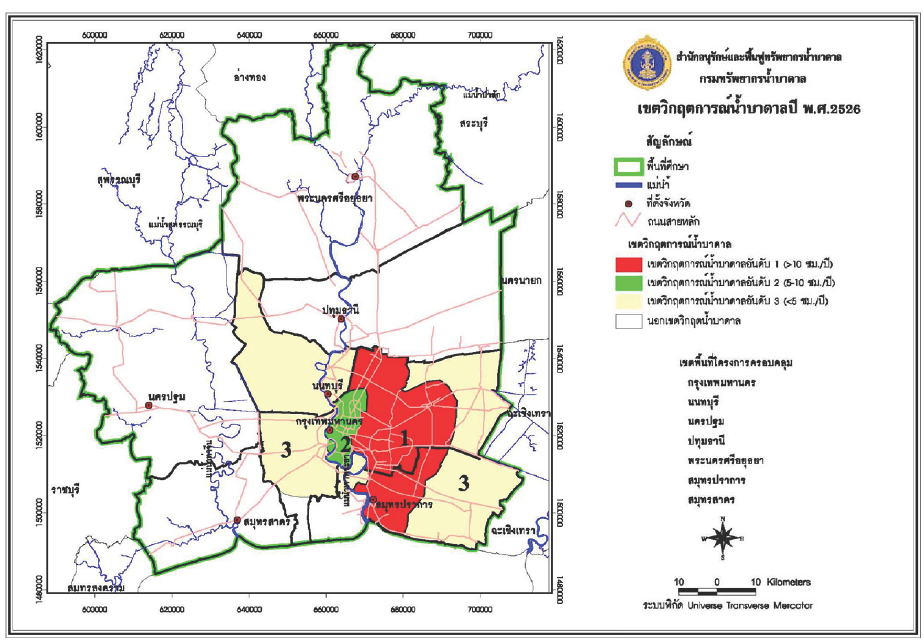
แผนที่การกำหนดเขตวิกฤตการณ์น้ำบาดาลเป็น 3 ระดับ ตามมติคณะรัฐมนตรีเมื่อวันที่ 15 มีนาคม 2526 ในเขตกรุงเทพมหานครและปริมณฑลรวม 4 จังหวัด คือ กรุงเทพมหานคร, นนทบุรี, ปทุมธานี และสมุทรปราการ
(ที่มา: กรมทรัพยากรน้ำบาดาล)
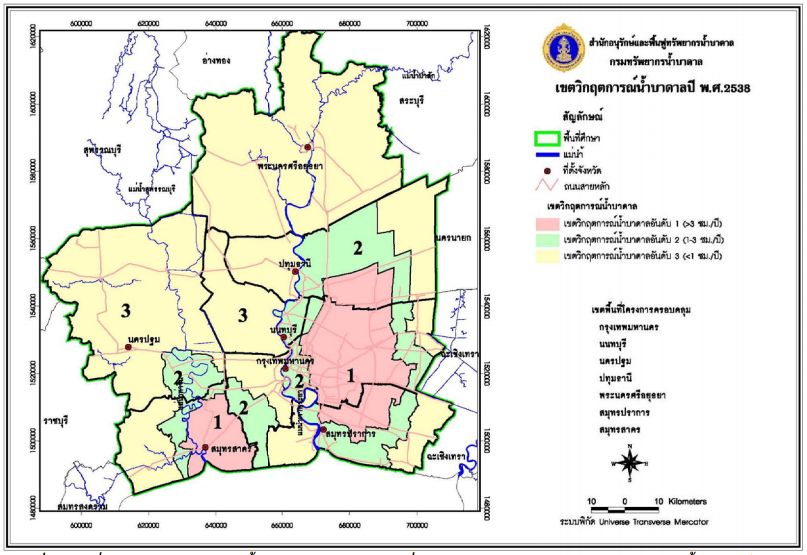
แผนที่การขยายเขตวิกฤตการณ์น้ำบาดาลและแผ่นดินทรุด เพิ่มเติมอีก 3 จังหวัด และกำหนดเขตวิกฤตการณ์น้ำบาดาลเป็น 3 ระดับ ตามมติคณะรัฐมนตรีเมื่อวันที่ 23 พฤษภาคม 2538 รวมครอบคลุมพื้นที่ 7 จังหวัด ได้แก่ กรุงเทพมหานคร, นนทบุรี, ปทุมธานี, สมุทรปราการ, นครปฐม, สมุทรสาคร และพระนครศรีอยุธยา (ที่มา: กรมทรัพยากรน้ำบาดาล)
Apart from the three critical zones, the Cabinet declared that there should be a zero groundwater extraction zone where a water supply system was available. Additionally, in the first and second critical zones, the government sector must stop using and treating groundwater for use in the regular water supply system. For the private sector, the Department of Groundwater Resources must monitor groundwater use and set up a different reduction rate for each time period. The Royal Thai Survey Department would carry out the land-subsidence survey annually. The Metropolitan Waterworks Authority and the Provincial Waterworks Authority would handle the water supply service within six provinces around Bangkok. The Department of Mineral Resources (the Department of Groundwater Resources now) should readjust the groundwater cost to approximately the same as tap water supply system.
Additionally, Pricing measures to limit usage were enforced by collecting groundwater bills from 3 February 1985 onwards. The areas include six provinces around Bangkok, except Nakorn Pathom. The readjusted rate was increased from 1 baht/ m3 (cubic meter) to 3 baht/ m3 in July 1994. From 18 January 1995 onwards, this rate was applied all over Thailand. From 1 August 2000, the rate increased from 3.5 baht/ m3 to 8.5 baht/ m3 in only seven provinces in the Bangkok vicinity and Nakorn Pathom by gradual raising the rate by 0.5 baht/ m3 each quarter. On 1 September 2004, stricter measures have been applied in groundwater critical zones including the seven provinces: Bangkok, Samut Prakan, Pathum thani, Nonthaburi, Samut Sakhon, Phra Nakhon Si Ayutthaya and Nakhon Pathom. This fixed rate would be applied for all either with or without a surface water supply system. Over two years, the gradual increase was 1 baht/ m3 each quarter to a total of 8.5 baht/ m3 by 1 July 2006.
The recent data from the Department of Groundwater Resources (the Groundwater Control Division) shows that Bangkok and its surrounding areas have a higher rate of groundwater usage than natural groundwater aquifers can collect. This leads to land-subsidence and seawater contamination. The average volume loss due to subsidence could also affect other ecosystems. Therefore, there should be regulatory measures to limit groundwater extraction which must not exceed 1.25 million cubic meters per day with each province following this table:
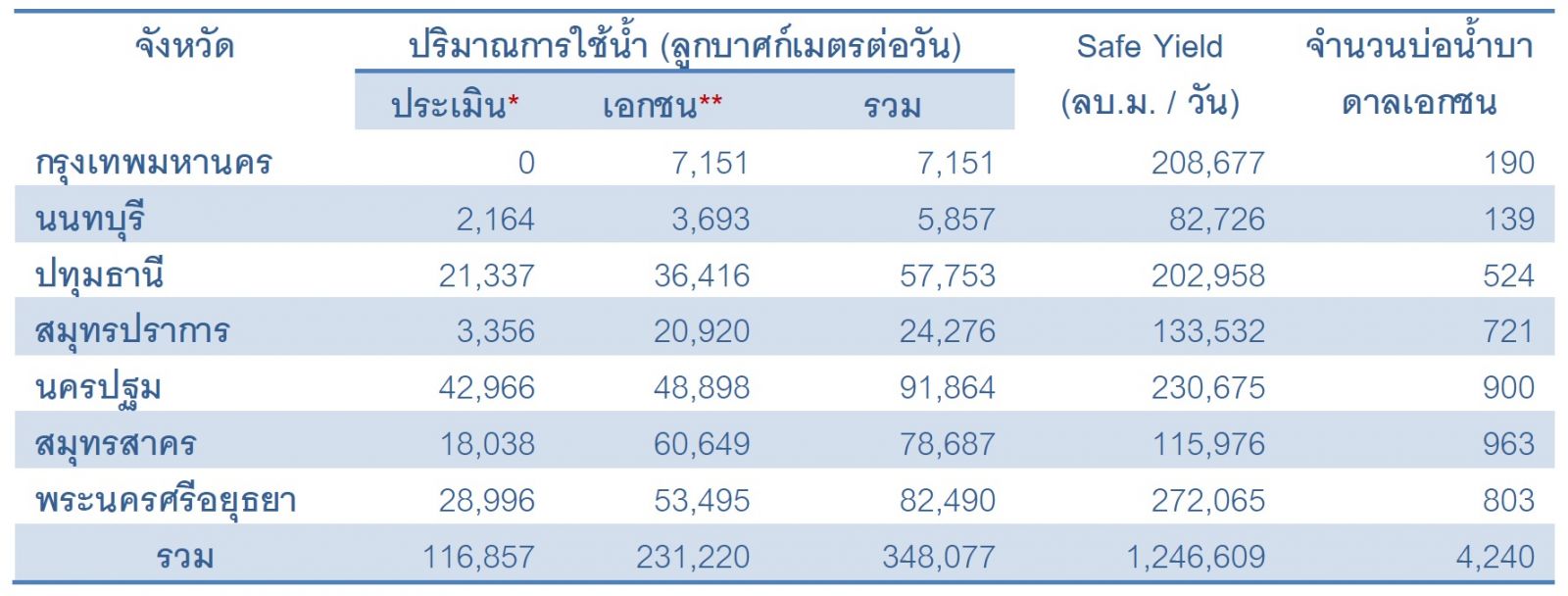
* ข้อมูลการใช้น้ำบาดาล อ้างอิงจากโครงการสำรวจสถานภาพบ่อน้ำบาดาล ศึกษากำหนดเครือข่ายบ่อสังเกตการณ์และประเมินการใช้น้ำบาดาลเพื่อการบริหารจัดการทรัพยากรน้ำบาดาลของประเทศปี 2552 โดยประเมินการใช้น้ำบาดาลของประปาหมู่บ้าน/เทศบาล และบ่อน้ำตื้น ร้อยละ 50 ของข้อมูลโครงการฯ เนื่องจากปัจจุบันมีการอดกลบบ่อเป็นจำนวนมาก
** ข้อมูลบ่อน้ำบาดาลเอกชน ใช้ข้อมูลปริมาณน้ำ การใช้น้ำจริง ณ ธันวาคม 2557 โดยข้อมูลบ่อน้ำเอกชน ประเภทอุปโภค-บริโภค และเกษตรกรรม ที่ไม่เก็บค่าใช้น้ำบาดาล ทำการประเมินน้ำใช้จริงร้อยละ 50 ของปริมาณน้ำตามใบอนุญาต
Due to previous measures, the consolidation process in the deep layers has led to declining land-subsidence as seen in the rising groundwater levels. The soft clay continues to subside in many areas and the ratio of compressed soft clay to rising deep layer clay is higher. Because urban sprawl and future commercial use might worsen the groundwater crisis due to an insufficient tap water supply system, it is expected that in 2027, the rate of groundwater use would increase to 1,386,411 cubic meters per day which will further subsidence at an average of 1.07 cm per year.
Go to 'จับตา' for “การควบคุมการใช้น้ำบาดาลกรุงเทพมหานครและปริมณฑล”
http://www.tcijthai.com/tcijthainews/view.php?ids=5724
www.facebook.com/tcijthai
Tags



